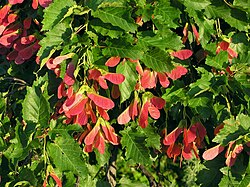| Acer tataricum | |
|---|---|
 | |
| Foliage and fruit, Saratov, Russia | |
| Scientific classification | |
| Kingdom: | Plantae |
| Clade: | Tracheophytes |
| Clade: | Angiosperms |
| Clade: | Eudicots |
| Clade: | Rosids |
| Order: | Sapindales |
| Family: | Sapindaceae |
| Genus: | Acer |
| Section: | Acer sect. Ginnala |
| Species: | A. tataricum |
| Binomial name | |
| Acer tataricum L. 1753 | |
 | |
| Acer tataricum sensu lato distribution; sensu stricto in green | |
| Synonyms [2] | |
List
| |
Acer tataricum, the Tatar maple or Tatarian maple, is a species of maple widespread across central and southeastern Europe and temperate Asia, from Austria and Turkey, and in some circumscriptions, with a disjunct population in eastern Asia in northern and central China, Japan and the Russian Far East. The species is named after the Tatar peoples of southern Russia; the tree's name is similarly commonly also misspelled "Tartar" or "Tartarian" in English. [3] [4]






